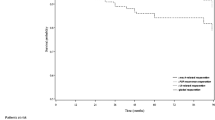Abstract
Objective
To report the perioperative adverse events associated with nerve-preserving sacropexy for pelvic organ prolapse (POP) repair and to identify risk factors that could predict possible adverse events.
Materials and methods
A total of 768 women who underwent sacropexy for POP repair performed by one surgeon using the same technique, beyond the learning curve, over a 10-year period, between January 1st 2007 and December 31st 2016.
Methods
The medical records of 768 women were reviewed for age, body mass index (BMI), tobacco use, previous surgeries (for POP and incontinence, abdominal surgeries in general), operating time, duration of hospitalization and perioperative events at time of surgery and 6 weeks postoperatively. Additionally, the complications were classified according to the Clavien–Dindo grading system and the Charlson Age Comorbidity Index (CACI) was evaluated for the patients.
Results
Between January 1st 2007 and December 31st 2016, 768 patients underwent sacropexy for POP. 27 (3.5%) adverse events occurred intra- and post-operative within 6 weeks after surgery. In univariate and multivariate analyses, only comorbidity and concomitant posterior colporrhaphy are significantly associated with complications.
Conclusions
Surgeon’s experience and a standardized technique minimize the risk of perioperative adverse events. The data on complications we found can be used to guide effective consent.


Similar content being viewed by others
References
Haylen BT, Maher CF, Barber MD, Camargo S, Dandolu V, Digesu A, Goldman HB, Huser M, Milani AL, Moran PA, Schaer GN, Withagen MI (2016) International Urogynecological Association (IUGA)/International Continence Society (ICS) joint report on the terminology for female pelvic organ prolapse (POP). Int Urogynecol J 27:655–684. https://doi.org/10.1007/s00192-016-3003-y
Wu JM, Matthews CA, Conover MM, Pate V, Jonsson Funk M (2014) Lifetime risk of stress urinary incontinence or pelvic organ prolapse surgery. Obstet Gynecol 123:1201–1206. https://doi.org/10.1097/AOG.0000000000000286
National Cancer Institute. Surveillance Research. Lifetime risk tables. http://seer.cancer.gov/csr/1975_2010/results_merged/topic_lifetime_risk.pdf. Accessed 10 Dec 2013
Maher C, Feiner B, Baessler K, Christmann-Schmid C, Haya N, Brown J (2016) Surgery for women with apical vaginal prolapse. Cochrane Datab Syst Rev. https://doi.org/10.1002/14651858.cd012376
Claerhout F, De Ridder D, Roovers JP, Rommens H, Spelzini F, Vandenbroucke V, Coremans G, Deprest J (2009) Medium-term anatomic and functional results of laparoscopic sacrocolpopexy beyond the learning curve. Eur Urol 55:1459–1467. https://doi.org/10.1016/j.eururo.2008.12.008
Anand M, Woelk JL, Weaver AL, Trabuco EC, Klingele CJ, Gebhart JB (2014) Perioperative complications of robotic sacrocolpopexy for post-hysterectomy vaginal vault prolapse. Int Urogynecol J 25:1193–1200. https://doi.org/10.1007/s00192-014-2379-9
Dindo D, Demartines N, Clavien PA (2004) A new proposal with evaluation in a cohort of 6336 patients and results of a survey. Ann Surg 240:205–213
Charlson M, Szatrowski TP, Peterson J, Gold J (1994) Validation of a combined comorbidity index. J Clin Epidemiol 47:1245–1251
Shiozawa T, Huebner M, Hirt B, Wallwiener D, Reisenauer C (2010) Nerve-preserving sacrocolpopexy: anatomical study and surgical approach. Eur J Obstet Gynecol Reprod Biol 152:103–107. https://doi.org/10.1016/j.ejogrb.2010.05.009
Unger CA, Paraiso MF, Jelovsek JE, Barber MD, Ridgeway B (2014) Perioperative adverse events after minimally invasive abdominal sacrocolpopexy. Am J Obstet Gynecol 211:547.e1–e8. https://doi.org/10.1016/j.ajog.2014.07.054
Bradley CS, Kenton KS, Richter HE, Gao X, Zyczynski HM, Weber AM, Nygaard IE (2008) Pelvic floor disorders network. obesity and outcomes after sacrocolpopexy. Am J Obstet Gynecol 199:690e1–e8. https://doi.org/10.1016/j.ajog.2008.07.030
Turner L, Lavelle E, Lowder J, Shepherd JP (2016) The impact of obesity on intraoperative complications and prolapse recurrence after minimally invasive sacrocolpopexy. Female Pelvic Med Reconstr Surg 22:317–323. https://doi.org/10.1097/SPV.0000000000000278
Centers for Disease Control and Prevention. Defining Overweight and Obesity. http://www.cdc.gov/obesity/adult/defining.html. Accessed 20 Apr 2015
Sung V, Weitzen S, Sokol ER, Rardin CR, Meyers DL (2006) Effect of patient age on increasing morbidity and mortality following urogynecologic surgery. Am J Obstet Gynecol 194:1411–1417
Richter HE, Goode PS, Kenton K, Brown MB, Burgio KL, Kreder K, Moalli P, Wright EJ, Weber AM, Network Pelvic Floor Disorders (2007) The effect of age on short-term outcomes after abdominal surgery for pelvic organ prolapse. J Am Geriatr Soc 55:857–863
Campbell P, Cloney L, Jha S (2016) Abdominal versus laparoscopic sacrocolpopexy: a systematic review and meta-analysis. Obstet Gynecol Surv 71:435–442. https://doi.org/10.1097/OGX.0000000000000335
Coolen AWM, van Oudheusden AMJ, Mol BWJ, van Eijndhoven HWF, Roovers JWR, Bongers MY (2017) Laparoscopic sacrocolpopexy compared with open abdominal sacrocolpopexy for vault prolapse repair: a randomised controlled trial. Int Urogynecol J 28:1469–1479. https://doi.org/10.1007/s00192-017-3296-5
Yamamoto M, Minikel L, Zaritsky E (2011) Laparoscopic 5-mm trocar site herniation and literature review. JSLS 15:122–126. https://doi.org/10.4293/108680811X13022985131697
Pereira N, Hutchinson AP, Irani M, Chung ER, Lekovich JP, Chung PH, Zarnegar R, Rosenwaks Z (2016) 5-millimeter trocar-site hernias after laparoscopy requiring surgical repair. J Minim Invasive Gynecol 23:505–511. https://doi.org/10.1016/j.jmig.2016.03.001
Siddiqui NY, Grimes CL, Casiano ER, Abed HT, Jeppson PC, Olivera CK, Sanses TV, Steinberg AC, South MM, Balk EM, Sung VW, Society of Gynecologic Surgeons Systematic Review Group (2015) Mesh sacrocolpopexy compared with native tissue vaginal repair: a systematic review and meta-analysis. Obstet Gynecol 125:44–55. https://doi.org/10.1097/aog.0000000000000570
Madsen LD, Nüssler E, Kesmodel US, Greisen S, Bek KM, Glavind-Kristensen M (2017) Native-tissue repair of isolated primary rectocele compared with nonabsorbable mesh: patient-reported outcomes. Int Urogynecol J 28:49–57. https://doi.org/10.1007/s00192-016-3072-y
Funding
This study was not funded.
Author information
Authors and Affiliations
Contributions
TK: conceptualization, formal analysis, literature search, writing—original draft, project administration. BS: conceptualization, formal analysis, data curation, software (figures, tables), writing—review and editing. MH: formal analysis, literature search, writing—review and editing. SYB: formal analysis, data curation, supervision, writing—review and editing. DW: formal analysis, data curation, supervision, writing—review and editing. CR: conceptualization, formal analysis, literature search, writing—original draft, writing—review and editing, project administration.
Corresponding author
Ethics declarations
Conflict of interest
The authors declare that they have no conflict of interest.
Research involving human participants and/or animals
This article does not contain any studies with human participants or animals performed by any of the authors. We have had full control of all primary data and we agree to allow the Journal to review our data if requested.
Rights and permissions
About this article
Cite this article
Kavvadias, T., Schoenfisch, B., Huebner, M. et al. Perioperative adverse events associated with pelvic organ prolapse repair by nerve-preserving sacropexy: an analysis of 768 cases over a 10-year period. Arch Gynecol Obstet 298, 353–361 (2018). https://doi.org/10.1007/s00404-018-4818-1
Received:
Accepted:
Published:
Issue Date:
DOI: https://doi.org/10.1007/s00404-018-4818-1



